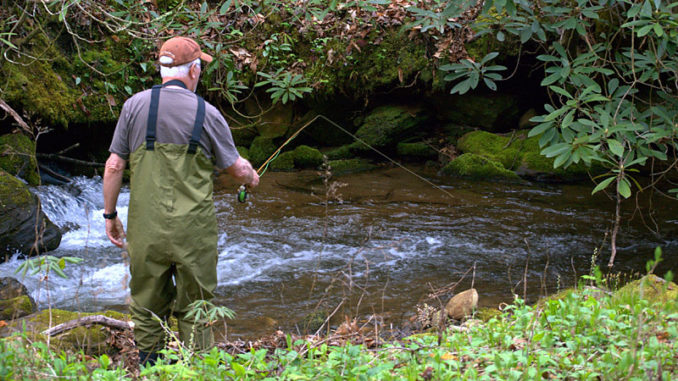
With insect hatches largely missing in summer, go to the big bugs
With few exceptions, major insect hatches have run their course, and trout are turning to more substantial fare: those land‑based insects called terrestrials.
These insects — ants, beetles, grasshoppers, crickets, bees, worms and caterpillars — usually begin showing up in late May and June. And they are a major part of a trout’s diet until the first freeze either kills them or sends them scurrying underground to await another season.
While delicate presentation is important when fishing with tiny “hatch” insects, a terrestrial should land in the water with a plop, according to Bruce Harang of Asheville, a former president of Smoky Mountain Fly Fishers.
“It’s a natural sound that immediately gets a trout’s attention,” he said. “Grasshoppers, beetles and the like aren’t dainty bugs. They land like a cargo plane.”
Since terrestrials usually are found in trees, bushes and grass along edges of streams, Harang said he casts as close to the bank as possible, 6 inches or so. That’s because trout know insects are more likely to fall into the water near the bank.
Hard landing
Also, he said, “If I’m casting to a fish I can see, I plop the fly down hard right behind the trout’s head, off to one side or the other. Nine times out of 10, the fish will instinctively react by turning and taking the fly. They don’t want to let a good‑sized bug get away.”
A wide variety of materials are used to make terrestrials. But Harang prefers deer‑hair patterns such as the Letort cricket and Letort hopper.
Another terrestrial pattern Harang favors is a Crowe beetle. “I also use Humpy patterns tied in yellow, brown, and black. These flies feature a bulbous body and are easier to see in late evening. They work extremely well on mountain streams.
Inchworms work well this time of year
Kevin Howell of Brevard, a trout fishing guide and owner of Davidson River Outfitters in Brevard, N.C., usually starts the terrestrial season with an inchworm.
“Both inchworms and beetles are present throughout the summer and fall,” he said.
Inchworms are good patterns because they work just about any place in a stream, from pools to riffles. Bead-head patterns are especially effective because the fly tumbles like a real inchworm. And the added weight gets the fly down into deeper water. That’s an important factor when fishing in hot weather.
In late summer. Howell uses a No. 12 or No. 10 caterpillar pattern.
“You see a lot of caterpillars this time of the year, and they’re always falling into the water,” he said.
In July and continuing through early September, Howell also fishes with black ants, either foam or dubbed, in Nos. 20 to 14.
Beetles and wind
“If you see trout feeding under tree overhangs, and the wind isn’t blowing, they’re usually feeding on beetles,” he said. “But if the wind is blowing, use an ant pattern. Ants are more likely to be blown into the water than beetles. Insects just don’t jump in the water and commit suicide. They either land in the water accidentally or they’re blown into the water.”
When fishing with beetles and ants, Howell uses long leaders, 8 or 9 feet, and a 7X tippet. This lets the fly ride on the surface and giving it an occasional twitch to make it appear more like a live insect struggling in the water.
Harang said the most-common ants found along stream banks are carpenter ants.
“I use a No. 16 to No. 14 with two black balls of dubbing separated by a midsection that has a few strands of peacock or pearl-colored Krystal Flash and a few turns of black CDC feather,” he said.
The Krystal Flash draws attention to the fly, and the CDC fibers wave like the legs of a real ant when it finds itself in the water.
“If an ant falls into the water, it will paddle its legs like there’s no tomorrow, and with a trout’s love of ants, there’s usually no tomorrow,” Harang said.
Sinking ants
Harang also uses an ant pattern with a lacquered‑thread body that allows the ant to sink.
“This is especially effective if you cast just above a shoot at the head of a pool and let the fly wash down into the pool,” he said.
Unlike spring hatches, terrestrials come in all shapes and sizes, and trout don’t see them in great numbers since they randomly fall or land in the water. What a trout does see when a terrestrial plops into a stream is a big mouthful of protein. Often enough, a big brown or rainbow trout will go out of its way to nab it.


Be the first to comment